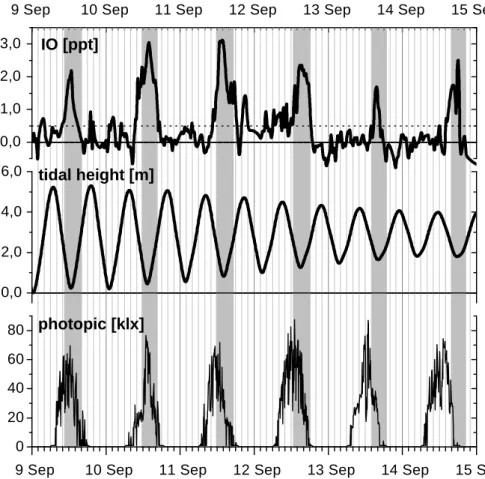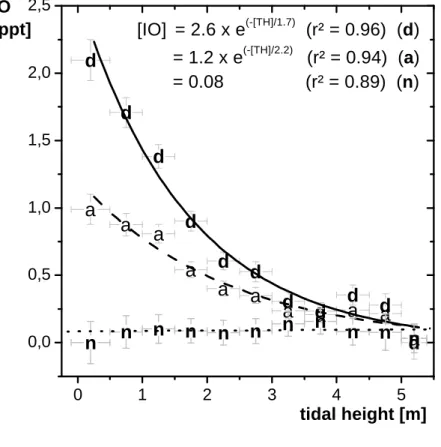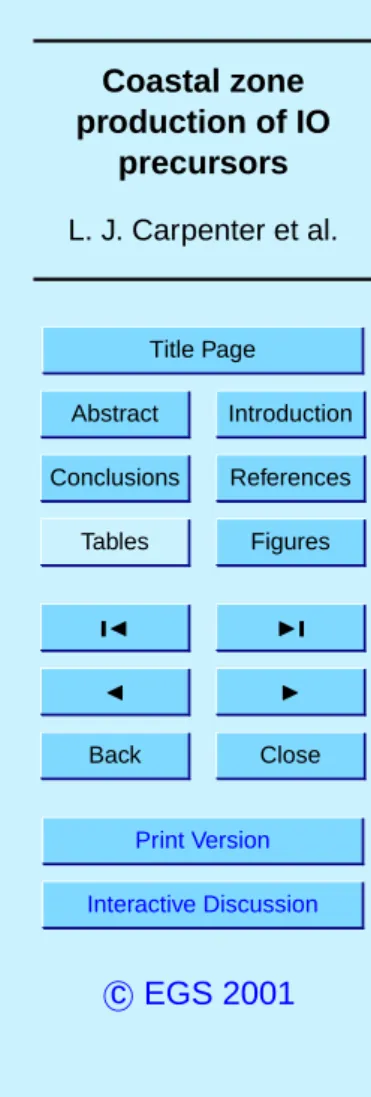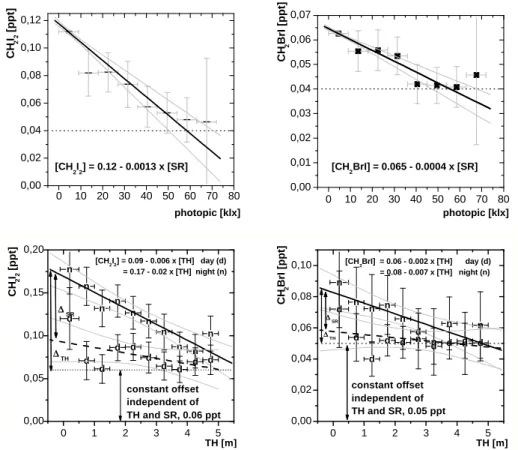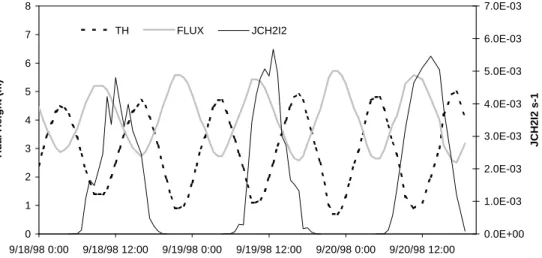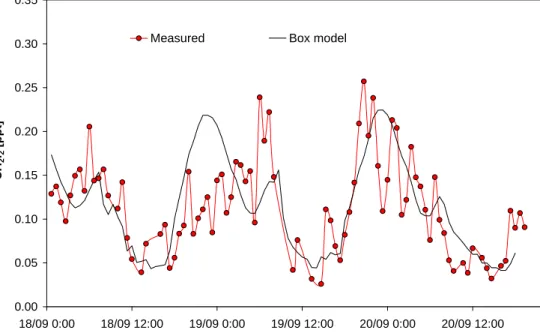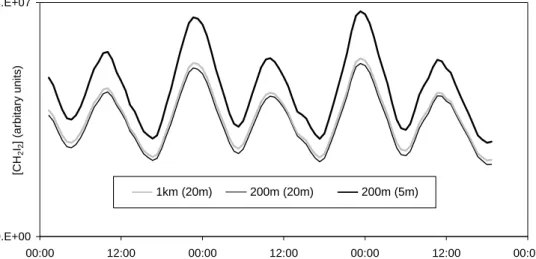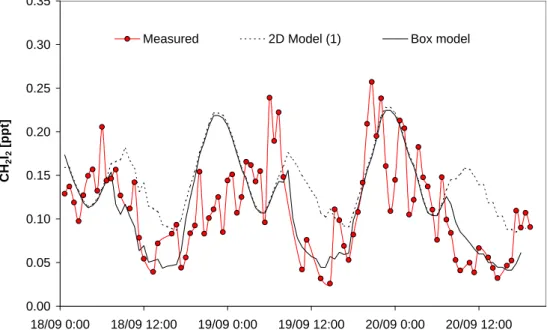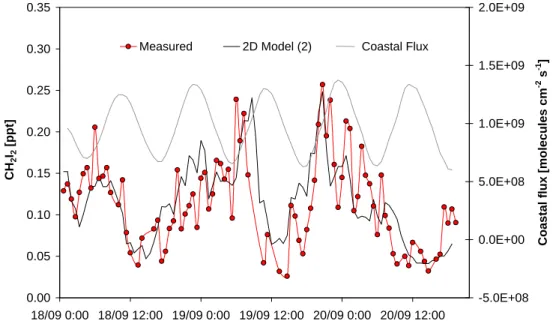HAL Id: hal-00300863
https://hal.archives-ouvertes.fr/hal-00300863
Submitted on 3 Sep 2001HAL is a multi-disciplinary open access
archive for the deposit and dissemination of sci-entific research documents, whether they are pub-lished or not. The documents may come from teaching and research institutions in France or abroad, or from public or private research centers.
L’archive ouverte pluridisciplinaire HAL, est destinée au dépôt et à la diffusion de documents scientifiques de niveau recherche, publiés ou non, émanant des établissements d’enseignement et de recherche français ou étrangers, des laboratoires publics ou privés.
Coastal zone production of IO precursors: A
2-dimensional study
L. J. Carpenter, K. Hebestreit, U. Platt, P. S. Liss
To cite this version:
L. J. Carpenter, K. Hebestreit, U. Platt, P. S. Liss. Coastal zone production of IO precursors: A 2-dimensional study. Atmospheric Chemistry and Physics Discussions, European Geosciences Union, 2001, 1 (1), pp.193-220. �hal-00300863�
ACPD
1, 193–220, 2001 Coastal zone production of IO precursors L. J. Carpenter et al. Title Page Abstract Introduction Conclusions References Tables Figures J I J I Back Close Print Version Interactive DiscussionAtmos. Chem. Phys. Discuss., 1, 193–220, 2001 www.atmos-chem-phys.org/acpd/1/193/
c
European Geophysical Society 2001
Atmospheric Chemistry and Physics Discussions
Coastal zone production of IO precursors:
A 2-dimensional study
L. J. Carpenter1, K. Hebestreit2, U. Platt2, and P. S. Liss3
1Department of Chemistry, University of York, York, YO10 5DD, U.K.
2Institut f ¨ur Umweltphysik, University of Heidelberg, INF 229, D-69120 Heidelberg, Germany 3School of Environmental Sciences, University of East Anglia, Norwich, NR4 7TJ, U.K.
Received: 13 August 2001 – Accepted: 16 August 2001 – Published: 3 September 2001 Correspondence to: L. J. Carpenter (ljc4@york.ac.uk)
ACPD
1, 193–220, 2001 Coastal zone production of IO precursors L. J. Carpenter et al. Title Page Abstract Introduction Conclusions References Tables Figures J I J I Back Close Print Version Interactive Discussion c EGS 2001 AbstractAt Mace Head, Eire, in the coastal East Atlantic, diiodomethane has been identified as an important precursor of iodine oxide radicals. Peak concentrations of both CH2I2and
IO at low water indicate that the intertidal region is a strong source of organo-iodines. Atmospheric measurements of CH2I2 made in marine air are used in conjunction with 5
a 2-dimensional model incorporating horizontal and vertical dispersion to provide esti-mates of the intertidal and offshore fluxes of CH2I2 upwind of Mace Head. The strong
signature of photolysis in the CH2I2 observations indicates that the emissions are not
entirely local/coastal, but must include an additional offshore source. Good agreement between model and measured CH2I2 concentrations is achieved with an offshore flux 10
of 2×104molecules cm−2s−1and an intertidal flux ranging from 1.3×109 molecules cm−2 s−1 (low water) to 6.5×108 molecules cm−2 s−1 (high water), the latter over a
100 m wide coastal belt. The coastal emissions at low water are in good agreement with independent estimates made from seaweed emission data. We estimate that, al-though intertidal emissions are ∼ 4 orders of magnitude higher than those offshore,
15
their contribution to the measured CH2I2concentrations at 10 m height is only∼50%.
1. Introduction
The last decade established that catalytic cycles involving halogen oxide radicals (BrO with smaller contributions from IO and ClO) were responsible for rapid ozone depletion events in the Arctic boundary layer during spring (Barrie et al., 1988; Bottenheim et
20
al., 1990; Barrie and Platt, 1997). More recently, the IO radical has been identified in Antarctica (Friess et al., 2001) and in the mid-latitudes (Alicke et al., 1999; Allan et al., 2000) in conjunction with organoiodine precursors (Carpenter et al., 1999), confirming the potential for the more widespread occurrence of boundary layer ozone depletion. Formation of IO is driven by ocean-atmosphere exchange of organo-iodines that are
25
ACPD
1, 193–220, 2001 Coastal zone production of IO precursors L. J. Carpenter et al. Title Page Abstract Introduction Conclusions References Tables Figures J I J I Back Close Print Version Interactive Discussionfound that a range of photolabile iodine containing organics including CH3I, C2H5I,
CH2ICl, CH2IBr and CH2I2 were present in sufficiently high concentrations to sustain
IO levels of a few parts per trillion (ppt), via the following reactions:
RI−→ R + Ihv (1)
I + O3 → IO + O2 (2)
5
Of the organoiodines measured, CH2I2 was found to be the most important iodine
precursor (Carpenter et al., 1999). The photodissociation lifetime of diiodomethane is only a few minutes at midday (Mossinger et al., 1998).
The impact of IO on ozone concentrations depends on the detailed gas phase and heterogeneous chemistry following reaction (2). Computational modelling
investiga-10
tions indicate that the rate of ozone destruction associated with iodine photochemistry in the marine boundary layer could equal that from HOx photochemistry (Vogt et al.,
1999; Stutz et al., 1999; McFiggans et al., 2000). Prediction of the global extent of iodine photochemistry is currently not possible because of the high uncertainty regard-ing the emissions and distributions of iodine precursors. Shipboard experiments have
15
identified CH2ICl (Klick and Abrahamsson, 1992; Schall et al., 1997) and CH2I2(Schall
et al., 1997) in the open ocean, although it is not yet established whether these orig-inate from microalgae (phytoplankton) or other (e.g. photochemical) sources. That coastal macroalgae are prolific emitters of a wide range of organic halogens is with-out doubt (e.g. Gschwend et al., 1985; Nightingale et al., 1995; Peders ´en et al., 1996;
20
Carpenter et al., 2000 and references therein), although the global budgets of seaweed emissions are very uncertain.
During the ACSOE (Atmospheric Chemistry Studies in the Oceanic Environment) experiment at Mace Head in 1997, macroalgal emissions were observed to have a direct impact on the local atmosphere, as reflected by the peak air concentrations of
ACPD
1, 193–220, 2001 Coastal zone production of IO precursors L. J. Carpenter et al. Title Page Abstract Introduction Conclusions References Tables Figures J I J I Back Close Print Version Interactive Discussion c EGS 2001 upon exposure (Carpenter et al., 2000). At high tide, emissions from submerged bedsare diluted in seawater and may undergo photolysis before exchange at the air- sea interface.
Measurements of organo-iodines and IO radicals at Mace Head were repeated dur-ing the 1998 EU project PARFORCE (New Particle Formation and Fate in the Coastal
5
Environment). In this study we utilise the dependence of organohalogens and IO con-centrations on tidal height to evaluate the relative importance of coastal and offshore emissions of CH2I2, providing further information on sources of the IO radical. A
Eu-lerian photochemical box model and a Lagrangian 2-dimensional model are used to estimate coastal and open ocean fluxes of CH2I2 and to predict its horizontal and ver-10
tical distributions in the coastal region.
2. Experimental
Mace Head is located on the remote western coast of County Galway, Eire (53◦19’ N, 9◦54’ W). The site is well known for background air measurements and receives rela-tively clean marine air from the prevailing westerly sector associated with the easterly
15
tracking cyclonic systems of the North Atlantic. The rocky upper littoral zone and cold waters provide favourable conditions for seaweeds.
2.1. Halocarbons
During the period 5–24 September 1998, halocarbons in air were monitored in-situ every 40 minutes with a Hewlett Packard 6890/5973 gas chromatograph/mass
spec-20
trometer (GC/MS) system. The GC/MS was operated in a laboratory situated ca. 100 m from the high tide mark, with a sampling inlet located with an open fetch to the ocean at a height of approx. 12m above mean sea level (MSL). The system is developed for automated air sampling and is described fully in Carpenter et al. (1999). Analysis was also performed on discrete samples of surface seawater and the water surrounding
ACPD
1, 193–220, 2001 Coastal zone production of IO precursors L. J. Carpenter et al. Title Page Abstract Introduction Conclusions References Tables Figures J I J I Back Close Print Version Interactive Discussioncubated seaweeds. For a full description of analytical procedures for air and seawater analyses during PARFORCE see Carpenter et al. (2000).
2.2. IO measurements by DOAS
Over a 1-month period from 8 September until 8 October 1998 LP DOAS (Long-Path Differential Optical Absorption Spectroscopy (Platt, 1994)) measurements of the
halo-5
gen oxides IO, OIO and BrO and of other atmospheric trace gases including NO2, O3,
HCHO, HONO and NO3 were carried out whenever the visibility allowed reasonable
signal to noise ratios.
Briefly, the principle of DOAS is the identification and quantification of atmospheric trace gases by their specific narrow (<5 nm) band optical absorption structure in the
10
open atmosphere, separating trace gas absorption from broad band molecule and aerosol extinction processes, thus allowing very sensitive detection of many molec-ular species (see e.g. Platt and Perner, 1983). The identification of the gases is un-ambiguous since their specific absorption structure is, similar to a fingerprint, unique. Calibration of the instrument is not necessary as long as the absorption cross section
15
is known.
A DOAS instrument based on the principle of Platt and Perner (Platt and Perner, 1983) was used at Mace Head. It incorporates a combination of two coaxially ar-ranged Newtonian telescopes, one collimating the light of a Xe-short-arc lamp through the atmosphere, the second recollecting the beam reflected by an array of quartz prism
20
retroreflectors. The telescopes were set up in a laboratory about 20 meters from the shore, while the retroreflector array was placed on the northern shore of the bay. The light beam was running at an average height of 10 meters above the ocean with a light path length of 2 ×7.27 km. A 0.5 m Czerny-Turner spectrograph (f = 6.9, 600 gr/mm grating, thermostated to 30 ± 0.3◦C), in combination with a 1024 pixel
ACPD
1, 193–220, 2001 Coastal zone production of IO precursors L. J. Carpenter et al. Title Page Abstract Introduction Conclusions References Tables Figures J I J I Back Close Print Version Interactive Discussion c EGS 2001 a spectral resolution of about 0.5 nm (a dispersion of 0.078 nm/pixel). Three furtherwavelength regions were chosen to detect BrO (335±40 nm) (H ¨onninger, 1999), OIO (550±40 nm) (Hebestreit, 2001), NO3(645±40 nm) and the other species absorbing
in the respective wavelength regions (O3, SO2, NO4, HCHO, NONO). Besides NO3,
all spectra were recorded using the multi channel scanning technique (Brauers et al.,
5
1995). The concentrations of IO were derived using a least squares fit mixer (Stutz and Platt, 1997) of the reference spectra of H2O, NO2 and IO, together with a sixth order
polynomial to the atmospheric absorption spectrum. The IO reference spectrum was measured in our laboratory, since no absorption cross section of sufficient resolution was available. NO2 was measured in a reference cell in the field. Absolute values for 10
both spectra were determined by comparison with literature cross sections (Cox et al., 1999; Harder et al., 1997; H ¨onninger, 1999). The H2O reference was calculated by a
convolution of the instrument function with the absorption cross section of the HITRAN database (HITRAN, 1987).
2.3. Model description
15
A 3-day period (18–20 September 1998, Julian days 261–263) of clean marine south-westerly air with stable temperatures (17.2 ± 1.9◦C) and wind speed (5.5 ± 1.0 m s−1) was selected as a case study for evaluation of marine emissions. Data were evaluated using models written in the FACSIMILE language. The photolysis rate of diiodomethane (J-CH2I2) was computed using a 2-stream radiative transfer model 20
(Hough, 1988), with absorption cross-sections from Mossinger et al. (1998) and TOMS O3 column data (http://toms.gsfc.nasa.gov/ozone/ozone01.html).
Pho-tolysis rates were corrected for cloud cover using the ratio of measured/modelled UVA data. The conventional box model assumed a boundary layer height of 1000 m whereas the 2-dimensional model incorporated a 11km long by 1000 m high slice
25
through the atmosphere divided into cells of 100 m length and 10 m height. Both mod-els were driven by 40-minute mean photolysis rates and a coastal CH2I2flux dependent
bot-ACPD
1, 193–220, 2001 Coastal zone production of IO precursors L. J. Carpenter et al. Title Page Abstract Introduction Conclusions References Tables Figures J I J I Back Close Print Version Interactive Discussiontom cell and transported across consecutive cell faces using the finite volume method to discretise the spatial partial derivatives, given by:
∂C ∂t = Q + D ∂2C ∂x2 − u ∂C ∂x (3)
whereC is the concentration of CH2I2, Q is the net rate of production and
destruc-tion, Dis the diffusion coefficient (set to zero for horizontal transport), the third term
5
representing advection, withuthe horizontal wind speed. Horizontal wind speed was parameterised with 40-minute averages of the measured mean values at 3 m height (de Leeuw et al., 2001). Measurements made at 22 m were typically∼10–15% higher (de Leeuw et al., 2001) as expected from the logarithmic dependence of wind speed with height and a roughness length,z0, of∼10−4m (Kunz et al., 2000). The simplifica-10
tion of assuming a height-independent wind speed should only introduce a significant error (over 20%) at altitudes of over∼50 m.
The rate of transport across the vertical boundary faces of each cell was described by replacing δx with δy and the eddy diffusivity coefficient, Kz, in place of D. The
diffusivity coefficient was assumed to vary with height in the surface layer according to
15
(cf. Stull, 1988): Kz =
κu∗z
φ(z/L) (4)
whereκis the von Karman constant (κ= 0.4),zis height,u∗is the friction velocity and
φ(z/L)is a stability correction equal to unity during neutrally stratified boundary layer conditions, which prevailed at Mace Head (de Leeuw et al., 2001). The friction velocity
20
was set to the mean of∼0.3 m s−1 measured during the chosen 3 days of study (de Leeuw et al., 2001).
ACPD
1, 193–220, 2001 Coastal zone production of IO precursors L. J. Carpenter et al. Title Page Abstract Introduction Conclusions References Tables Figures J I J I Back Close Print Version Interactive Discussion c EGS 2001 3. Results and discussion3.1. Relationships of iodine species with tidal height and solar radiation
Analysis of PARFORCE data showed that tidal height (TH) and solar radiation (SR) were correlated with CH2I2, IO, and to a lesser extent, CH2IBr air concentrations.
Fig-ure 1 shows IO, tidal height and solar radiation at 555 nm (photopic flux in kW/m2 = 5
klx) for the period 9–15 September. The daily IO maximum shifted simultaneously with the minimum in TH (about one hour from day to day), showing that both solar flux and tidal height controlled the time of the IO peak. It is clear from Fig. 1 that the maximum IO concentrations occurred when the lowest tidal heights overlapped significantly with maximum solar irradiance. Figure 2 shows correlations of IO versus TH for daytime
10
values only (d), all data (a), and night-time values (n) of the 4 week measurement pe-riod. Under daylight conditions, high IO values were clearly associated with low tidal height, while at night no correlation between IO and TH was found. The correlation was described well by an exponential decrease with rising tide (r2 = 0.96).
Figure 3 illustrates that the influence of both tidal height and solar flux on CH2I2 15
concentrations was observed during the clean marine south-westerly air period 18–20 September 1998. Hebestreit (2001) analysed the whole 3 week period of halocarbon measurements and found that [CH2I2]night = 0.17 − 0.02[TH] and [CH2I2]all = 0.12 −
0.0013[SR]. Scatter plots for CH2I2and CH2IBr concentrations with TH and SR for the
whole campaign period are shown in Fig. 4. Strong evidence for these organic iodines
20
as important photolytic precursors of IO is evident from their decreasing concentrations with solar flux and, during night-time, maxima at low tide. Note that although peak concentrations of organo-iodines were observed at low water, both CH2I2 and CH2IBr
exhibited non-zero concentrations above their detection limits of 0.03 pptv even at high tide, presumably due to offshore (open ocean) sources, as discussed later.
25
Given that the organoiodine precursors exhibited linear dependencies with TH, the cause of the exponential relationship of IO with TH (Fig. 2) does not appear to be explained by source variations and is possibly attributable to the photochemistry of IO.
ACPD
1, 193–220, 2001 Coastal zone production of IO precursors L. J. Carpenter et al. Title Page Abstract Introduction Conclusions References Tables Figures J I J I Back Close Print Version Interactive DiscussionIt should also be noted that the IO measurements represent averages over ∼7 km, whereas the organoiodines were measured by point sampling.
3.2. Box model simulations
The photochemical box model was used to test the causality of the observed CH2I2
correlations. The model was parameterised with J-CH2I2 and tidal height data for the 5
18–20 September. A TH- dependent emission rate was derived which accurately re-flected the observed CH2I2 dependencies on TH and SR. The best fit to the data was
achieved using an emission rate inversely proportional to TH, as shown (arbitary scale) in Fig. 5. The resulting [CH2I2]modelledcorrelations with TH and SR are shown in Fig. 6.
Comparison with Fig. 4 shows that the modelled dependencies were in good
agree-10
ment with those observed, suggesting that the extent of tidal influence in the flux term was parameterised appropriately and that the correlation of CH2I2 with SR observed
during PARFORCE was caused solely by photolysis of CH2I2.
The CH2I2concentrations predicted by the model also showed generally good
agree-ment with the measureagree-ments made during 18–20 September, as shown in Fig. 7. Thus
15
it can be inferred that the estimated TH-dependent flux term was generally applica-ble, since it had been derived from correlations observed during the whole period of measurements. The tidal influence on CH2I2concentrations at Mace Head was clearly
significant. However, the flux derived from the box model can only be regarded as a qualitative indicator of emissions. The small source-sampling distance and short
life-20
time of CH2I2 preclude the quantitative use of a box model, which assumes well-mixed
concentrations throughout the boundary layer. A 2-dimensional model incorporating atmospheric dispersion is a more appropriate tool for quantitatively investigating emis-sions in this case.
ACPD
1, 193–220, 2001 Coastal zone production of IO precursors L. J. Carpenter et al. Title Page Abstract Introduction Conclusions References Tables Figures J I J I Back Close Print Version Interactive Discussion c EGS 2001 3.3. 2-dimensional model simulationsBefore carrying out detailed computations, the sensitivity of the output of the 2-dimensional model to the height of the overall grid and of each cell was determined. Figure 8 compares the CH2I2concentrations predicted at 20 m height using (i) a 1000 m
high grid with 20 m high cells, (ii) a 200 m high grid with 20 m high cells and (iii) a 200 m
5
high grid with 5 m high cells. The difference between the first two computations was negligible. The slightly higher concentrations predicted by (iii) can be explained by the difference in resolutions: (i) and (ii) were averages of CH2I2over 20–40 m and therefore
lower in concentration than the average of 20–25 m.
The final grid size selected was 11 km by 200 m, with 10 m high and 100 m wide
10
cells. Offshore ocean emissions were represented by the first 1 km of the grid and TH-dependent coastal emissions by the following 100 m belt prior to the station. The organoiodine sampling point of the Mace Head station was represented by the second lowest (10–20 m) cell, at a horizontal distance of 1.1 km from the start of the grid. The effect of marine emissions could therefore be observed over the following 10 km and
15
up to 200 m altitude.
An upper limit to the coastal flux was evaluated from the initial model scenario of no ocean emissions. The TH-dependent emission rate used in this scenario was qualita-tively the same as shown in Fig. 5, scaled to provide good agreement with the mean observed CH2I2 concentrations. The resulting simulations are compared to the CH2I2 20
observations and box model results in Fig. 9. The tidal-height dependent flux required to match the measurements was 5.4×109 molecules cm−2 s−1 at low water and 2.6
×109 molecules cm−2s−1 at high water.
A clear discrepancy between model and measurements is apparent. The 2-dimensional model showed that the small distance between source and sampling left
25
insufficient time for photolysis to deplete daytime levels of CH2I2to the extent observed.
As a sensitivity test, the photolysis rate was increased by a factor of two, but this did not resolve the discrepancy. An alternative flux situation was investigated, wherein the
ACPD
1, 193–220, 2001 Coastal zone production of IO precursors L. J. Carpenter et al. Title Page Abstract Introduction Conclusions References Tables Figures J I J I Back Close Print Version Interactive Discussionoffshore region was also a source of CH2I2. The average surface seawater
concentra-tion of CH2I2 between 200 m and 5 km offshore of Mace Head during the PARFORCE
campaign was 0.52±0.26 pmol L−1 and the mean seawater temperature was 12◦C (Carpenter et al., 2000). The equilibrium air concentration at this temperature calcu-lated using the Henry’s law coefficient for CH2I2 reported by Moore et al. (1995) is 0.1 5
pptv. Thus, it is difficult to assess whether or not the offshore waters of Mace Head were a source of CH2I2 or simply in equilibrium. An upper limit to the flux can
how-ever be calculated using a CH2I2 concentration in air of zero. From the Liss-Merlivat
expression (Liss and Merlivat, 1986) with a square root molecular weight correction for the transfer velocity (Liss and Slater, 1974) and the mean wind speed, an upper limit
10
to the ocean flux was estimated as 2×105 molecules cm−2s−1.
Various combinations of coastal and open ocean fluxes within the upper limit of the offshore flux described above were computed. The best fit to the observed CH2I2data
was achieved using an ocean flux of 2×104 molecules cm−2s−1and a TH-dependent coastal flux of 1.3× 109 molecules cm−2 s−1 at low water and 6.5× 108 molecules 15
cm−2s−1at high water. The coastal flux and a comparison of the 2D simulation (calcu-lated using 40-minute average wind speed data) with observed and box model data are shown in Fig. 10. The figure shows that the 2D model correctly reproduced the daytime depletion of CH2I2 when an offshore ocean source was included. The contributions of
the offshore and coastal emissions to the modelled CH2I2 concentrations at the Mace 20
Head station were found to be approximately equal, due to the larger ocean surface area. A sensitivity study was carried out to test the effect of changing the coastal flux. Doubling the coastal flux increased the modelled CH2I2 concentration by a factor of
∼four, whereas decreasing the flux by a factor of ten decreased the CH2I2
concentra-tion by only a factor of two. Thus, the coastal flux derived should therefore be regarded
25
ACPD
1, 193–220, 2001 Coastal zone production of IO precursors L. J. Carpenter et al. Title Page Abstract Introduction Conclusions References Tables Figures J I J I Back Close Print Version Interactive Discussion c EGS 2001 3.4. Independent estimates of intertidal CH2I2emissionsIn addition to atmospheric measurements made during PARFORCE, the release rates of organic bromines and iodines from seaweeds were determined from incubations in seawater of ten species of brown, red and green macroalgae collected in the in-tertidal or subtidal zones of the rocky shore (Carpenter et al., 2000). These studies
5
provide independent estimates of coastal CH2I2 emissions. The most prevalent
sea-weeds present in the intertidal zone at Mace Head, in common with most Northern European rocky shores (Michanek, 1975), were the brown algae Laminaria digitata, Laminaria saccharina and Ascophyllum nodosum. These algae are also among the most productive in terms of CH2I2 emissions, with mean production rates of 8.3, 1.9 10
and 0.36 pmol g−1 fresh weight hr−1, respectively (Carpenter et al., 2000). Estimates of total kelp density from data provided by the Irish Seaweed Industry Organisation (ISIO) are 11.6 kg m−2(Carpenter et al., 2000). However this value includes Laminaria hyboborea, which is only present at depth, therefore the kelp density of the intertidal zone should be reduced by∼25% (Carpenter et al., 2000). Assuming the density is
15
evenly spread between L.digitata, L. saccharina and A. nodosum and over the intertidal zone leads to a total CH2I2emission rate of∼1.5×109molecules cm−2s−1. Given the
many assumptions made in both this estimate and the 2D model estimate of emissions at low water, the remarkable agreement between the two may be fortuitous. However, it demonstrates that our estimate should certainly be of the right order of magnitude.
20
In addition, the agreement suggests that algae emit CH2I2directly into the surrounding
air at a similar rate as into a seawater medium (from which the production rates were measured).
3.5. Prediction of spatial variation of CH2I2 concentrations
The estimated open ocean and coastal emissions were used in the 2D model to predict
25
the horizontal and vertical distributions of CH2I2 in the coastal region. Figure 11 shows
ACPD
1, 193–220, 2001 Coastal zone production of IO precursors L. J. Carpenter et al. Title Page Abstract Introduction Conclusions References Tables Figures J I J I Back Close Print Version Interactive DiscussionSTP) were predicted to be present at altitudes of ∼100 m, several kilometres from the station. However, the uplift of the plume may have been overestimated at night, due to the model utilising 24 h average eddy diffusivity coefficients. During the day, concentrations of over 2 × 106 molecules cm−3 CH2I2 were predicted to be present
only near ground level and within ∼100 m of the station horizontally. The modelled
5
variation of CH2I2 concentration with time up to 50 m altitude at the horizontal point of
the station is shown in Fig. 12.
4. Summary and conclusions
Strong evidence for the organoiodines CH2I2and CH2IBr as photolytic precursors to the
IO radical at Mace Head was shown from the dependence of all three species on tidal
10
height. Iodine oxide concentrations peaked at low water during midday hours and the reactive organoiodines, whose lifetimes are less than 1 hour at midday, peaked when low water coincided with night. Using a 2-dimensional model to simulate atmospheric dispersion, upper limits of the flux rate of CH2I2 from exposed seaweed beds at low
water at Mace Head was estimated as 1.3×109 molecules cm−2 s−1, and about half 15
this value at high water. The coastal emissions at low water were in good agreement with independent estimates made from seaweed emission and density data. Combined with an offshore emission rate of 2 × 104 molecules cm−2 s−1, the modelled CH
2I2
concentrations showed good agreement with the measurements. The model showed that the non- zero CH2I2 concentrations observed at Mace Head during the day could 20
be explained by proximity to source. However, some contribution from offshore sources was necessary to reproduce the observed daytime depletion of CH2I2, suggesting an
ACPD
1, 193–220, 2001 Coastal zone production of IO precursors L. J. Carpenter et al. Title Page Abstract Introduction Conclusions References Tables Figures J I J I Back Close Print Version Interactive Discussion c EGS 2001campaign. Financial support for this project was provided by the Natural Environment Re-search Council (NERC) grant GR9/03597.
References
Alicke B., Hebestreit, K., Stutz, J., and Platt, U., Iodine oxide in the marine boundary layer, Nature, 397, 572–573, 1999.
5
Allan B. J., McFiggans, G., Plane, J. M. C., and Coe, H., Observations of iodine monoxide in the remote marine boundary layer, J. Geophys. Res., 105, 14363–14369, 2000.
Barrie, L. A., Bottenheim, J. W., Schnell, R. C., Crutzen P. J., and Rasmussen, R. A., Ozone destruction and photochemical reactions at polar sunrise in the lower Arctic atmosphere, Nature, 334, 138–141, 1988.
10
Barrie, L.A. and Platt, U., Arctic tropospheric chemistry: an overview, Tellus, 49B (5), 450–454, 1997.
Bottenheim, J. W., Barrie, L. A., Atlas, E., Heidt, L. E., Niki, H., Rasmussen, R. A., and Shep-son, P. B., Depletion of lower tropospheric ozone during Arctic spring: The Polar Sunrise Experiment, J. Geophys. Res., 95, 18555–18568, 1990.
15
Brauers, T., Hausmann, M., Brandenburger, U., and Dorn, H.-P., Improvement of Differential Optical Absorption Spectroscopy with a multichannel scanning technique, Applied Optics, 34, 4472–4479, 1995.
Cox, R. A., Bloss, W. J., Jones, R. L., and Rowley, D. M., OIO and the Atmospheric Cycle of Iodine, Geophysical Research Letters, 26 (13), 1857–1860, 1999.
20
Carpenter, L. J. and Liss, P. S., On temperate sources of bromoform and other reactive organic bromine gases, J. Geophys. Res., 105, 20, 539–20, 548, 2000.
Carpenter, L. J., Sturges, W. T., Liss, P. S., Penkett, S. A., Alicke B., Hebestreit, K., and Platt, U., Short lived alkyl-iodides and bromides at Mace Head: Links to macroalgal emission and halogen oxide formation, J. Geophys. Res, 104, 1679, 1999.
25
Carpenter, L. J., Malin, G., Kuepper, F., and Liss, P. S., Novel biogenic iodine-containing tri-halomethanes and other short-lived halocarbons in the coastal East Atlantic, Global Bio-geochem. Cycles, 14, 1191–1204, 2000.
De Leeuw, G., Kunz, G. J., and O’Dowd, C. D., Micro-meteorological measurements at the Mace Head mid-latitude coastal station, Submitted to J. Geophys. Res., 2001.
ACPD
1, 193–220, 2001 Coastal zone production of IO precursors L. J. Carpenter et al. Title Page Abstract Introduction Conclusions References Tables Figures J I J I Back Close Print Version Interactive Discussion Friess, U., Wagner, T., Pundt, I., Pfeilsticker, K., and Platt, U., Spectroscopic Measurements ofTropospheric Iodine Oxide at Neumayer Station, Antarctica, Geophysical Research Letters, 28, 10, 1941–1944, 2001.
Gschwend, P. M., Macfarlane J. K., and Newman, K. A., Volatile halogenated organic-compounds released to seawater from temperate marine macroalgae, Science, 227, 1033– 5
1035, 1985.
Harder, J. W., Brault, J. W., Johnston, P. V., and Mount, G. H., Temperature dependent NO2
cross sections at high spectral resolution, J. Geophys. Res., 102, 3861–3879, 1997. HITRAN, HITRAN database 1986 edition, Applied Optics, 26, 4058–4097, 1987.
H ¨onninger, G., Referenzspektren reaktiver Halogenverbindungen f ¨ur DOAS Messungen, 10
Diploma thesis, Ruprecht Karls Universit ¨at Heidelberg, Heidelberg, 1999.
Hough, A. M., The calculation of photolysis rates for use in global troposheric modelling studies, AERE Report R-13259, 53, HMSO, London, 1988.
Klick, S. and Abrahamsson, K., Biogenic volatile iodated hydrocarbons in the ocean, J. Geo-phys. Res., 97, 12683–12687, 1992.
15
Kunz, G. J., Cohen, L. H., and de Leeuw, G., Lidar and micrometeorological measurements dur-ing the PARFORCE experiments at the Mace Head Atmospheric Research Station, Carna, Ireland, during September and June 1998.
Liss, P. S. and Merlivat, L., Air-sea exchange rates: Introduction and synthesis, in Role of Air-Sea Exchange in Geochemical Cycling, edited by P. Buat-M ´enard, 113–127, D. Reidel 20
Publishing Company, Dordrecht, 1986.
Liss, P. S. and Slater, P. G., Flux of gases across the air-sea interface, Nature, 247, 181–184, 1974.
McFiggans, G., Allan, B., Coe, H., Plane, J. M. C., Carpenter, L. J., and O’Dowd, C., Obser-vations of IO and a modelling study of iodine chemistry in the marine boundary layer, J. 25
Geophys. Res., 105, 14, 371–14, 385, 2000.
Michanek, G., Seaweed resources of the ocean, FAO Fish. Tech. Pap., 138, 127, 1975. Moore, R. M., Geen, C. E., and Tait, V. K., Determination of Henry’s Law constants for a suite
of naturally occurring halogenated methanes in seawater, Chemosphere, 30, 1183–1191, 1995.
ACPD
1, 193–220, 2001 Coastal zone production of IO precursors L. J. Carpenter et al. Title Page Abstract Introduction Conclusions References Tables Figures J I J I Back Close Print Version Interactive Discussion c EGS 2001Nightingale P. D., Malin, G., and Liss, P. S., Production of chloroform and other low-molecular-weight halocarbons by some species of macroalgae, Limnol. Oceaongr., 40, 680–689, 1995. Peders ´en, M., Coll ´en, J., Abrahamsson, K., and Ekdahl, A., Production of halocarbons from
seaweeds–an oxidative stress reaction, Scientia Marina, 60, 257–263, 1996.
Platt, U., Differential optical absorption spectroscopy (DOAS), Chemical Analysis Series, 127, 5
1994.
Platt, U. and Perner, D., Measurements of atmospheric trace gases by long path differen-tial UV/visible absorption spectroscopy, in Optical and Laser Remote Sensing, edited by Killinger, D. A. and Mooradien, A., 95–105, Springer Verlag, New York, 1983.
Schall, C., Heumann, K. G., and Kirst, G. O., Biogenic volatile organoiodine and organobromine 10
hydrocarbons in the Atlantic Ocean from 42 degrees N to 72 degrees S, Fres. J. Anal. Chem., 359, 298–305, 1997.
Stull, R. B., An introduction to boundary layer meteorology, Kluwer Academic Publishers, Dor-drecht, 1988.
Stutz, J. and Platt, U., Improving long-path differential optical absorption spectroscopy with a 15
quartz-fiber mode mixer, Applied Optics, 36, 1105–1115, 1997.
Stutz, J., Hebestreit, K., Alicke, B., and Platt, U., Chemistry of halogen oxides in the tropo-sphere: comparison of model calculations with recent field data, Journal of Atmospheric Chemistry, 34, 65–85, 1999.
Vogt, R., Sander, R., von Glasow, R., and Crutzen, P. J., Iodine chemistry and its role in halogen 20
activation and ozone loss in the marine boundary layer: A model study, J. Atmos. Chem., 32, 375–395, 1999.
ACPD
1, 193–220, 2001 Coastal zone production of IO precursors L. J. Carpenter et al. Title Page Abstract Introduction Conclusions References Tables Figures J I J I Back Close Print Version Interactive Discussion 0,0 2,0 4,0 6,0 0,0 1,0 2,0 3,09 Sep 10 Sep 11 Sep 12 Sep 13 Sep 14 Sep 15 Sep
9 Sep 10 Sep 11 Sep 12 Sep 13 Sep 14 Sep 15 Sep
0 20 40 60 80 photopic [klx] tidal height [m] Date 1998, UT IO [ppt]
ACPD
1, 193–220, 2001 Coastal zone production of IO precursors L. J. Carpenter et al. Title Page Abstract Introduction Conclusions References Tables Figures J I J I Back Close Print Version Interactive Discussion c EGS 2001 0 1 2 3 4 5 0,0 0,5 1,0 1,5 2,0 2,5a
a
a
a
a
a
a
a
a
a
a
d
d
d
d
d
d
d
d
d
d
d
n
n
n
n
n
n
n
n
n
n n
tidal height [m][IO]
= 2.6 x e
(-[TH]/1.7)(r² = 0.96) (
d)
= 1.2 x e
(-[TH]/2.2)(r² = 0.94) (
a)
= 0.08 (r² = 0.89) (
n)
IO [ppt] n = night d = day a = all dataACPD
1, 193–220, 2001 Coastal zone production of IO precursors L. J. Carpenter et al. Title Page Abstract Introduction Conclusions References Tables Figures J I J I Back Close Print Version Interactive Discussion 0 0.1 0.2 0.3 9/18/98 0:00 9/19/98 0:00 9/20/98 0:00 9/21/98 0:00 CH 2 I2 [ppt] 0 1 2 3 4 5 6 7TH [m], Photopic flux [kLux*0.1]
Measured SR Tidal Height
ACPD
1, 193–220, 2001 Coastal zone production of IO precursors L. J. Carpenter et al. Title Page Abstract Introduction Conclusions References Tables Figures J I J I Back Close Print Version Interactive Discussion c EGS 2001 0 10 20 30 40 50 60 70 80 0,00 0,02 0,04 0,06 0,08 0,10 0,12 0 10 20 30 40 50 60 70 80 0,00 0,01 0,02 0,03 0,04 0,05 0,06 0,07 CH 2 I2 [ppt] [CH 2I2] = 0.12 - 0.0013 x [SR] photopic [klx] [CH 2BrI] = 0.065 - 0.0004 x [SR] photopic [klx] CH 2 BrI [ppt] 0 1 2 3 4 5 0,00 0,05 0,10 0,15 0,20 0 1 2 3 4 5 0,00 0,02 0,04 0,06 0,08 0,10 0,20 n n n n n n n n n n d d d d d d d d d d n n n n n n n n n n d d d d d d d d d d TH [m] ∆∆ SR ∆∆ TH constant offset independent of TH and SR, 0.06 ppt [CH 2I2] = 0.09 - 0.006 x [TH] day (d) = 0.17 - 0.02 x [TH] night (n) CH 2 I2 [ppt] ∆∆ SR ∆∆ TH constant offset independent of TH and SR, 0.05 ppt TH [m] [CH 2BrI] = 0.06 - 0.002 x [TH] day (d) = 0.08 - 0.007 x [TH] night (n) CH 2 BrI [ppt]Fig. 4. Correlations of CH2I2 and CH2IBr with SR and TH for the whole measurement period.
The correlation with TH is divided into night-time (n) and day-time (d) values of CH2I2 and
ACPD
1, 193–220, 2001 Coastal zone production of IO precursors L. J. Carpenter et al. Title Page Abstract Introduction Conclusions References Tables Figures J I J I Back Close Print Version Interactive Discussion 0 1 2 3 4 5 6 7 8 9/18/98 0:00 9/18/98 12:00 9/19/98 0:00 9/19/98 12:00 9/20/98 0:00 9/20/98 12:00 Tidal Height (m) 0.0E+00 1.0E-03 2.0E-03 3.0E-03 4.0E-03 5.0E-03 6.0E-03 7.0E-03 JCH2I2 s-1 TH FLUX JCH2I2Fig. 5. The tidal-height dependent CH2I2 flux rate (FLUX, arbitary units) used in the model,
ACPD
1, 193–220, 2001 Coastal zone production of IO precursors L. J. Carpenter et al. Title Page Abstract Introduction Conclusions References Tables Figures J I J I Back Close Print Version Interactive Discussion c EGS 2001 y = -0.01x + 0.09 y = -0.02x + 0.24 0.00 0.05 0.10 0.15 0.20 0.25 0 1 2 3 4 5 Tidal Height [m] CH 2 I2 [ppt] y = -0.001x + 0.102 0.02 0.04 0.06 0.08 0.10 0.12 0.14 0.16 0 10 20 30 40 50 60 70 Photopic [Klux] CH 2 I2 [ppt]Fig. 6. Correlations of (a) tidal height and (b) solar flux with CH2I2 concentrations predicted
by the box model. In Fig. 6a, night-time data is represented by the filled triangles and daytime data by the open squares.
ACPD
1, 193–220, 2001 Coastal zone production of IO precursors L. J. Carpenter et al. Title Page Abstract Introduction Conclusions References Tables Figures J I J I Back Close Print Version Interactive Discussion 0.00 0.05 0.10 0.15 0.20 0.25 0.30 0.35 18/09 0:00 18/09 12:00 19/09 0:00 19/09 12:00 20/09 0:00 20/09 12:00 CH 2 I2 [ppt]Measured Box model
ACPD
1, 193–220, 2001 Coastal zone production of IO precursors L. J. Carpenter et al. Title Page Abstract Introduction Conclusions References Tables Figures J I J I Back Close Print Version Interactive Discussion c EGS 2001 0.E+00 3.E+07 00:00 12:00 00:00 12:00 00:00 12:00 00:00 [CH 2 I2 ] (arbitary units) 1km (20m) 200m (20m) 200m (5m)Fig. 8. CH2I2 concentrations predicted at 20 m by the 2-dimensional model at different grid
ACPD
1, 193–220, 2001 Coastal zone production of IO precursors L. J. Carpenter et al. Title Page Abstract Introduction Conclusions References Tables Figures J I J I Back Close Print Version Interactive Discussion 0.00 0.05 0.10 0.15 0.20 0.25 0.30 0.35 18/09 0:00 18/09 12:00 19/09 0:00 19/09 12:00 20/09 0:00 20/09 12:00 CH 2 I2 [ppt]Measured 2D Model (1) Box model
Fig. 9. Comparison of 2D model predictions of CH2I2, calculated using only coastal sources,
ACPD
1, 193–220, 2001 Coastal zone production of IO precursors L. J. Carpenter et al. Title Page Abstract Introduction Conclusions References Tables Figures J I J I Back Close Print Version Interactive Discussion c EGS 2001 0.00 0.05 0.10 0.15 0.20 0.25 0.30 0.35 18/09 0:00 18/09 12:00 19/09 0:00 19/09 12:00 20/09 0:00 20/09 12:00 CH 2 I2 [ppt] -5.0E+08 0.0E+00 5.0E+08 1.0E+09 1.5E+09 2.0E+09Coastal flux [molecules cm
-2 s -1 ]
Measured 2D Model (2) Coastal Flux
Fig. 10. Comparison of 2D model predictions of CH2I2, calculated using both coastal and
offshore sources, with measurements. The tidal height – dependent coastal flux inferred by the model is also shown.
ACPD
1, 193–220, 2001 Coastal zone production of IO precursors L. J. Carpenter et al. Title Page Abstract Introduction Conclusions References Tables Figures J I J I Back Close Print Version Interactive Discussion wind directionMace Head Station
midnight midday 0 2 4 6 8 10 100 80 60 40 20 0 distance (km) height (m)
2.0e+006 4.0e+006 6.0e+006
0 2 4 6 8 10 100 80 60 40 20 0 distance (km) height (m)
2.0e+006 5.0e+006 8.0e+006 wind direction
wind direction
wind direction
Mace Head Station
midnight midday 0 2 4 6 8 10 100 80 60 40 20 0 distance (km) height (m)
2.0e+006 4.0e+006 6.0e+006
0 2 4 6 8 10 100 80 60 40 20 0 distance (km) height (m)
2.0e+006 5.0e+006 8.0e+006 wind direction
wind direction
Fig. 11. The spatial variation of CH2I2concentrations predicted by the 2D model at (a) midnight
ACPD
1, 193–220, 2001 Coastal zone production of IO precursors L. J. Carpenter et al. Title Page Abstract Introduction Conclusions References Tables Figures J I J I Back Close Print Version Interactive Discussion c EGS 2001 0 12 24 36 48 60 50 40 30 20 10 0 time (hr) height (m)1.0e+006 4.0e+006 7.0e+006
0 12 24 36 48 60 50 40 30 20 10 0 time (hr) height (m)
1.0e+006 4.0e+006 7.0e+006
Fig. 12. Variation of CH2I2 with height at the Mace Head station as predicted by the 2D
model for the period 18–20 September. The colour scale represents the CH2I2 concentration
